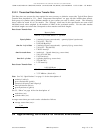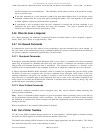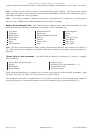
USER RESPONSIBLE FOR VERIFYING VERSION AND COMPLETENESS
OEM FUNCTIONAL SPECIFICATION ULTRASTAR XP (DFHC) SSA MODELS 1.12/2.25 GB - 1.0" HIGH
Table 9. Track (or Head) Skew for several block lengths
3.6 Idle Time Functions
The execution of various functions by the drive during idle times may result in delays of commands
requested by initiators. ‘Idle time’ is defined as time spent by the drive not executing a command requested
by a initiator. The functions performed during idle time are:
1. Servo Run Out Measurements
2. Servo Bias Measurements
3. Predictive Failure Analysis (PFA)
4. Channel Calibration
5. Save Logs and Pointers
6. Disk Sweep
The command execution time for commands received while performing idle time activities may be increased
by the amount of time it takes to complete the idle time activity. The messages and data exchanged across
the SSA link are not affected by idle time activities.
Note: Command Timeout Limits do not change due to idle time functions.
All Idle Time Functions have mechanisms to lessen performance impacts for critical response time periods of
operation. And in some cases virtually eliminate those impacts from an Initiator's point of view. All Idle
Time Functions will only be started if the drive has not received a SCSI command for at least 5 seconds (40
seconds for Sweep). This means that multiple SCSI commands are accepted and executed without delay if
the commands are received by the drive within 5 seconds after the completion of a previous SCSI command.
This mechanism has the benefit of not requiring special system software (such as issuing SCSI Rezero Unit
commands at known & fixed time intervals) in order to control if and when this function executes.
Note: Applications which can only accommodate Idle Time Function delays at certain times, but can not
guarantee a 5 second re-instruction period, may consider synchronizing idle activities to the system needs
through use of the LITF bit in Mode Select Page 0, and the Rezero Unit command. Refer to the Ultrastar
XP (DFHC) SSA Models Interface Specification for more details
Following are descriptions of the various types of idle functions, how often they execute and their duration.
Duration is defined to be the maximum amount of time the activity can add to a command when no errors
occur. No more than one idle function will be interleaved with each command.
Following the descriptions is a summary of the possible impacts to performance.
Notch #
User bytes / logical
block
1 2 3 4 5 6 7 8 9 10
256 20 20 20 19 19 17 17 17 17 15
512 13 13 13 12 12 11 11 10 10 10
520 12 12 12 12 11 11 10 10 10 10
522 12 12 12 12 11 11 10 10 10 9
524 12 12 12 12 11 11 10 10 10 9
528 12 12 12 12 11 11 10 10 10 9
600 11 11 11 11 10 10 10 9 9 9
688 10 10 10 10 9 9 9 9 8 8
744 9 9 9 9 9 9 8 8 8 7
Note: Contact an IBM Customer Representative for values at other formatted block lengths.
Source filename=PERFORM IBM Corporation Page 47 of 87


















